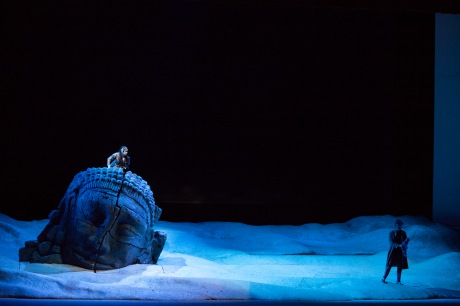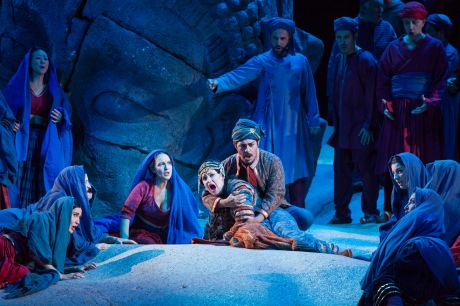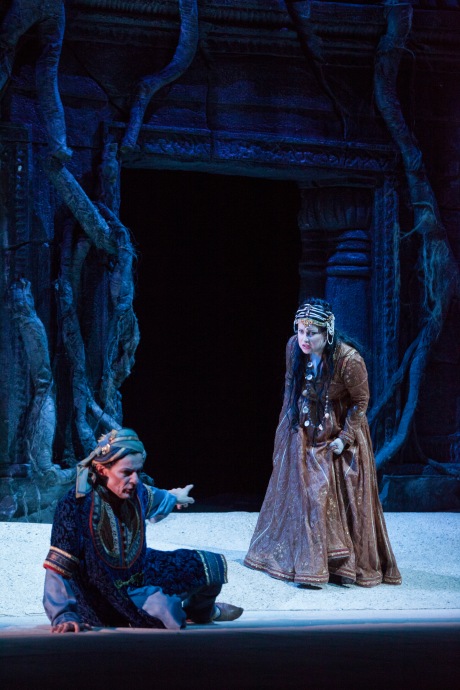Although the engaging one-act Le Docteur Miracle had been produced when he was only nineteen, Les pȇcheurs de perles was Bizet’s first relatively successful opera, a product of his twenty-fourth year. It shows few signs of the dramatic cogency of Carmen, which came only a dozen years later, but the score is nonetheless a cornucopia of memorable tunes. Its popularity is perhaps also due to the musical spell the composer seems to cast over his lovers, a kind of erotic hypnosis felt most powerfully (but not exclusively) in the tenor’s Act I aria and in his duet with Zurga and Léïla. It pervades the entire score with its ambiguity to the point of making it difficult to individuate the true couple within an otherwise commonplace soprano/tenor/baritone triangle.

Firenze, Febbraio 2016, un momento della prova antegenerale de LES PE?CHEURS DE PERLES, diretto da Ryan McAdams con la regia di Fabio Sparvoli. Florence, February 2016, a moment of the antegenerale reharshals of LES PÊCHEURS DE PERLES, conducted by Ryan McAdams with the direction by Fabio Sparvoli.
Although the opera met with the audience’s favour, critics – with the notable exception of Berlioz – reviled it in such a way that it vanished from the stages and was never revived during Bizet’s lifetime. However, in the 1870s and 1880s Italian audiences could not have enough of French opera, and the published Sonzogno filled Italian opera houses with works of the likes of Meyerbeer, Gounod, Massenet, Thomas among others; and so, just like Carmen, even Les pȇcheurs de perles, or better I pescatori di perle, after its successful debut at Teatro alla Scala in 1886, acquired international success in an Italian translation, which was significantly different from the 1863 original version. The French publisher and score owner Choudens published a couple of versions with three important modifications: the cabaletta concluding the tenor/baritone act I duet was excised and replaced with the reprisal of the big tune “Oui, c’est elle! C’est la déesse”, even if this melody (known as the “motif de la déesse) would resurface eight more times before the end of the opera; cuts were made within the Act III duet between soprano and baritone, and in particular they removed the allegro moderato, a piece of quite innovative and formally free music that gives a perfect idea of the first seeds of doubt and jealousy being planted into Zurga’s mind. Last but not least, the finale of the opera was thoroughly re-written by Benjamin Godard, who eliminated the open ending devised by Bizet where Nadir and Léïla run away singing the “déesse” melody, and inserted a formal trio that ended with Zurga being stabbed to death by the vengeful Nourabad. The Florentine performance under review has inappropriately mixed the two versions: though it has fortunately retained Bizet’s finale, it has also made the ugly cut in the third act soprano/baritone duet as well as dug out the spurious version of the first act tenor/baritone duet, an unfortunate choice because in this fashion the two characters renew their friendship vows employing music (the usual “déesse) reminiscent of the ultimate cause of their past contrasts. On the other hand, the tenor was not allowed to conclude his “romance” with the cadenza climbing to a high C, which Bizet wrote only for the horns, a tasteless and theatrically ineffective cadenza in as much as it destroys the sense of Nadir’s slow languidness and falling asleep.

Firenze, Febbraio 2016, un momento della prova antegenerale de LES PE?CHEURS DE PERLES, diretto da Ryan McAdams con la regia di Fabio Sparvoli. Florence, February 2016, a moment of the antegenerale reharshals of LES PÊCHEURS DE PERLES, conducted by Ryan McAdams with the direction by Fabio Sparvoli.
Ryan McAdams conducted this hybrid with remarkable control, managing to find the delicate balance between the pages exuding exotic languor and the feral, frenzied ones, which often follow one another rather abruptly. In my opinion, the most problematic part of the opera is the first act finale: Léïla’s aria, which should be imbued with ecstatic mysticism, flows into a frivolous 6/8 certainly not improved by the participation of the chorus that with its barcarolle rhythm make one believe to have been suddenly transported into the Giulietta act of Les contes d’Hoffmann. McAdams succeeds into reducing this involuntary comedy of Singhalese fishers turned into Venetian gondoliers to a minimum, choosing discreet and hushed dynamics. One had the feeling he was champing at the bit eager to sweep in with impetuosity in the third act duet, but he was obviously aware of the limitations of the two singers, particularly the soprano, who would be drowned by such a vigour. Léïla was Ekaterina Sadovnikova, a Russian soprano gifted with a pleasant, soft grained timbre, respectable agility and an easy top (she chose the higher variant in the first act finale cadenza reaching a long beautiful D 6). However, even though it is often assigned to light sopranos, Léïla has on the contrary a very central if now downright lowish tessitura, which is certainly not Ms. Sadovnikova’s comfort zone. In “Comme autrefois” only the horn could be heard, but it was particularly in the third act duet, when Léïla, tired of imploring, loses her patience (and I’d like to bring attention to the similarity between her “Venge toi donc” and Carmen’s “Frappe moi donc) that the lack of incisiveness and frustrated desperation was sorely missed: theatrical phrases such as “Je te maudis, je te hais” went for nothing. Only some caution in his third act duet hinted at the indisposition that Luca Grassi announced; for the rest, he displayed his usual good schooling allowing him to produce a rich compact sound, remarkable extension and an excellent top — and the role of Zurga lies on a very high tessitura, hammering on the passaggio and peppered with F, Fs sharp and Gs (and even an optional high A which Grassi, like all the other baritones I have heard in this role, did not attempt). In Italian a “signor baritono” means a first class baritone, but I will also use the expression “Baryton-seigneur”, a category of baritones that flourished in nineteenth century France to indicate a singer able to express extreme feelings such as anger and jealousy but always within a most aristocratic phrasing. Jesús Garcia, a Texan tenor who has been active for over fifteen years, was at his Italian debut in an opera often present in his resume. Considering his familiarity with the role, it was legitimate to expect more, much more. It gives me no pleasure to write that the American tenor turned out to be rather disappointing. He failed to be convincing in the most intimate pages, such as the Act II “Chanson” and especially “Je crois entendre encore”, where his high notes were nothing more than emaciated falsettos unable to float and run across and over the orchestra, and the final middle E naturale was short and unsupported. Even worse were the most dramatic moments, such as the Act II finale, where he could not be heard at all, and even the purely lyrical ones (the duets with soprano and baritone) in which Garcia, a light tenor with a slightly throaty and hardly charming timbre, was inevitably covered by his colleagues. Nicolas Testè has made a specialty of the role of Nourabad and his experience was greatly appreciated. The Chorus of the Maggio Musicale Fiorentino, which plays an important, perhaps excessive role in the economy of this opera, maintained its usual high standard: even in these darkest hours of the Fondazione the excellence of the chorus has always remained a bright spot.

Firenze, Febbraio 2016, un momento della prova antegenerale de LES PE?CHEURS DE PERLES, diretto da Ryan McAdams con la regia di Fabio Sparvoli. Florence, February 2016, a moment of the antegenerale reharshals of LES PÊCHEURS DE PERLES, conducted by Ryan McAdams with the direction by Fabio Sparvoli.
There is no need to linger on the production by Fabio Sparvoli (with sets by Giorgio Ricchelli, costumes by Alessandra Torella): originated in Trieste in 2007, it has already travelled to Verona, Naples, Modena and Parma, accumulating dozens of reviews; it is mostly pleasant to the eye, but does not make any attempt at giving layers of depth to characters that are burden with cliches already on paper (one of the very first reviewers wrote that, just like in Europe, even in India sopranos run away with tenors: “poor baritones, less loved and less paid than tenors!”). It would have been particularly stimulating to elaborate the psychology of Zurga, the only multifaceted character, with particular attention to his relationship with Nadir, a selfish and egocentric man in spite of the immortal melodies Bizet lavishes on him. Zurga is usually seen as the hero sacrificing his happiness on behalf of the happiness of his lover (which one? or both of them?), but we tend to forget that in order to facilitate their escape he has set fire to a village putting in serious danger the lives of many children. He is a character worthy of much deeper attention by those who put him on stage. The unusually numerous audience welcomed the performance without particular warmth and enthusiasm.
Nicola Lischi
three stars
Photo credit: Simone Donati – TerraProject – Contrasto